Ponds
What is a pond?
It is a permanent and still water stretch (there is no current). Its depth doesn’t exceed one meter which allows the sun to heat the bottom of the pond, contrarily to lakes which are much deeper.
Why are ponds disappearing?
In the past there was always a pond near farmhouses, for all uses but mostly acting as troughs, water supply against fires or for watering the vegetable plot, cress cultivation and other plants… However, there have been drastic changes in farmhouses and ponds in that they were considered to be useless and were therefore dried up or filled.
Why defend our ponds?
Our ponds and small lakes mustn’t disappear. They are crucially vital for animals and plants. Amphibians (frogs, toads, salamanders) spend their whole life within 500 meters of the pond where they were born. Chances are very slim for them to find another water point within this distance. Consequently, we must make sure we stop destroying better and even better we restore to their original state those who were damaged or filled. Near amphibians, there are loads of insects and aquatic plant birds using these water points.
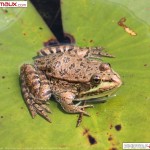 FROGS
FROGS
These amphibians live both in water and on land. For them there is no survival, without a puddle or a pond. They reproduce and lay their eggs in water from which tadpoles hatch, Tadpoles are said to be frogs in their infancy. They spend all this period of life in water eating like horses in order to grow up quickly
After a while small legs grow on them while their tails disappear. The tadpoles have become frogs.
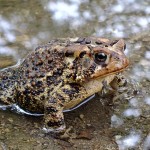 TOADS
TOADS
They are also amphibians but they spend more time on land because unlike their cousins their thick granular skin don’t dehydrate as quickly .
From early spring, they go into water to lay their eggs which then become tadpoles.
Toads and frogs can be all sizes and all colours. They love walking around the pond on rainy days. If you happen to walk by a pond one day, keep your eyes open !
 DRAGONFLIES
DRAGONFLIES
From the eggs laid by the female dragonfly, larva will hatch after a while, feeding greedily on numerous aquatic animals. After a year, they come out of the water along a stem. Their skins open up and out comes a dragonfly. Their eyesight is excellent. In flight they hunt flying insects.
Most dragonflies don’t live long, only a few weeks once they have reached adult stage
 An example of pond fish: the stickleback
An example of pond fish: the stickleback
Only 4 to 5cm big, often spotted in ponds, they have a spine on their back. During breeding season, the male becomes bright red and blue. To seduce its loved one, it deploys all its treasures of attention. It begins by making a nest of mud and plant clippings in order to attract a female there. Then it starts a kind of zig zag dance top down. How energetic ! If the female shows some interest, she then lays thousands of eggs in the next which will be fertilized by Sir Stickleback afterwards.
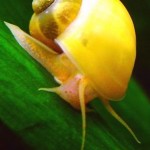 Freshwater snails
Freshwater snails
Most freshwater snails live in ponds or lakes.
Like their terrestrial cousins, freshwater snails are gastropods. They boast both elegant and useful shells, similar to divers’ bottles. Indeed, they can sometimes be spotted on the water surface coming to renew the air trapped in their shells before diving back underneath.
There are also snails with gills allowing them to absorb oxygen like fish.
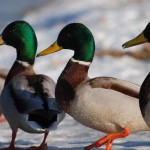 DUCKS
DUCKS
You have undoubtedly come across these large birds living in groups on water. They are all sizes and all colours.
They are very inquisitive and greedy: they love breadcrumbs thrown by passers- by. However don’t feed them with cakes or anything else… they would become very sick.
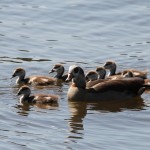
In Spring , you will be able to spot female ducks and their off springs surfing on water in single tail. Their father is never far away , ready to fend off the enemies.

BATS
They come and eat small insects at dusk.
… go and discover pond animals
Here is a list of things you must keep in mind:
A pond explorer : loves and protects nature
• watches where he puts his feet in
• does not throw pebbles
• gets closer to small animals in silence
• does not try to catch them
• does not break plant stems
• does not pick flowers
• does not leave garbage in nature
How to watch aquatic animals properly
Rather than capture pond animals, it is much better to watch them in their natural habitat. In order to to that, you can use your own « aquascope » thanks to which you can observe them without disturbing them and without getting wet. Careful: water needs to be clear to be able to use your aquascope, If you want to keep all your fingers whole, enrol your parents or your elder brother’s help
You will need
• a 60cm long x 12 cm wide plastic pipe ( for example a pipe used for gutters)
• a robust plastic piece (plexiglas) 2mm thick
• silicone and its applicator
• sanding paper
• a saw or a sharp knife
Here is what you do :
• cut the plastic pipe to size: the shorter and wider, the clearer view you will have;
• take a piece of plexiglass and cut it to fit the pipe diameter : this is the submarine part of your viewer
• apply the silicone coating all around the plexiglas cone and fix it onto the edge of the plastic pipe;
• when it is in the right place, apply some coating all around on the outer part,
• make a dent on the other end of the plastic pipe: sand the sharp edges to make them smooth, then you will not hurt the tip of your nose…
Now you are ready to do some animal watching…
Don’t dip your viewer deep in water: just be careful that your submarine viewer’s window remains under water
Which plants live in the pond? and how?
If you are asked to draw a plant, nine times out of ten, it will be a flower, unless you think bigger and you draw a shrub or even a tree. Very few of us would think about drawing an aquatic plant although there are many interesting species of all sizes and shapes.
They fall more or less into four categories
• plants whose stem is solely in water (e.g reed)
• those floating on the water surface without being anchored to the bottom (e.g duckweed)
• those whose roots touch bottom and have leaves floating on the surface ( waterlilies)
• and finally those who roots touch bottom and live entirely under the water
Like land plants, aquatic plants need to breath, to feed and to breed, however,they don’t do always do it in the same way, especially those who are totally subaquatic have devised unusual ways to survive For example they spread their seeds in water
Submarine life is a far cry from life on land and aquatic plants are totally different: they have a flexible stem and they use water force to stand up right and have no need for a hard stem like most land plants.
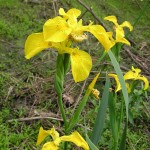
The yellow flag iris
This iris with remarkable yellow flowers colours our ponds in spring and attracts clouds of small insects and beetles seeking shelters in its leaves and petals. It is either in water or next to it.
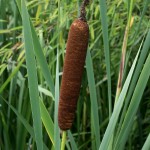
THE BROAD-LEAVED CAT TAIL PLANT
This riverbank plant can reach up to 2 meters. It is easily identified when it is blooming with a large dark brown cigar shape and plentiful silky grains in autumn dispersing with the wind.
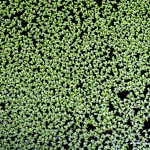
DUCKWEEDS
This small plant with oval leaves, barely a few millimeters in diameter drifts on the water surface and has roots floating underneath it. This is a very invasive species, sometimes completely covering up ponds


